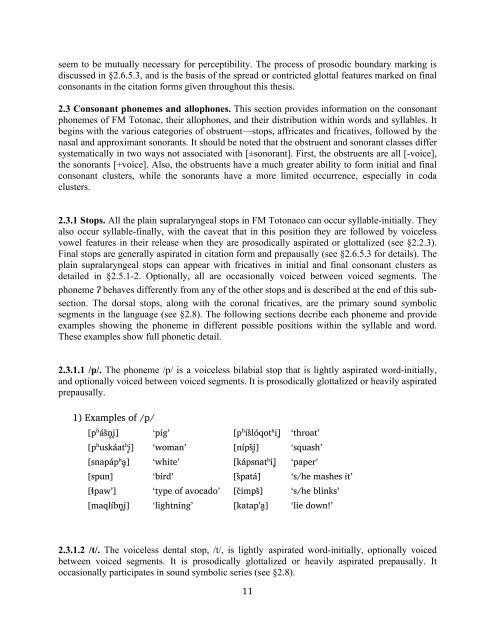The phonology and morphology of Filomeno Mata Totonac
The phonology and morphology of Filomeno Mata Totonac
The phonology and morphology of Filomeno Mata Totonac
Create successful ePaper yourself
Turn your PDF publications into a flip-book with our unique Google optimized e-Paper software.
seem to be mutually necessary for perceptibility. <strong>The</strong> process <strong>of</strong> prosodic boundary marking is<br />
discussed in §2.6.5.3, <strong>and</strong> is the basis <strong>of</strong> the spread or contricted glottal features marked on final<br />
consonants in the citation forms given throughout this thesis.<br />
2.3 Consonant phonemes <strong>and</strong> allophones. This section provides information on the consonant<br />
phonemes <strong>of</strong> FM <strong>Totonac</strong>, their allophones, <strong>and</strong> their distribution within words <strong>and</strong> syllables. It<br />
begins with the various categories <strong>of</strong> obstruent—stops, affricates <strong>and</strong> fricatives, followed by the<br />
nasal <strong>and</strong> approximant sonorants. It should be noted that the obstruent <strong>and</strong> sonorant classes differ<br />
systematically in two ways not associated with [±sonorant]. First, the obstruents are all [-voice],<br />
the sonorants [+voice]. Also, the obstruents have a much greater ability to form initial <strong>and</strong> final<br />
consonant clusters, while the sonorants have a more limited occurrence, especially in coda<br />
clusters.<br />
2.3.1 Stops. All the plain supralaryngeal stops in FM <strong>Totonac</strong>o can occur syllable-initially. <strong>The</strong>y<br />
also occur syllable-finally, with the caveat that in this position they are followed by voiceless<br />
vowel features in their release when they are prosodically aspirated or glottalized (see §2.2.3).<br />
Final stops are generally aspirated in citation form <strong>and</strong> prepausally (see §2.6.5.3 for details). <strong>The</strong><br />
plain supralaryngeal stops can appear with fricatives in initial <strong>and</strong> final consonant clusters as<br />
detailed in §2.5.1-2. Optionally, all are occasionally voiced between voiced segments. <strong>The</strong><br />
phoneme $ behaves differently from any <strong>of</strong> the other stops <strong>and</strong> is described at the end <strong>of</strong> this subsection.<br />
<strong>The</strong> dorsal stops, along with the coronal fricatives, are the primary sound symbolic<br />
segments in the language (see §2.8). <strong>The</strong> following sections decribe each phoneme <strong>and</strong> provide<br />
examples showing the phoneme in different possible positions within the syllable <strong>and</strong> word.<br />
<strong>The</strong>se examples show full phonetic detail.<br />
2.3.1.1 /p/. <strong>The</strong> phoneme /p/ is a voiceless bilabial stop that is lightly aspirated word-initially,<br />
<strong>and</strong> optionally voiced between voiced segments. It is prosodically glottalized or heavily aspirated<br />
prepausally.<br />
1) Examples <strong>of</strong> /p/<br />
[p%ás"n&i&] ‘pig’ [p%is"lóqot h i]& ‘throat’<br />
[p%uskáat h i&] ‘woman’ [níps"i&] ‘squash’<br />
[snapáp h a&] ‘white’ [kápsnat h i]& ‘paper’<br />
[spun] ‘bird’ [s"patá] ‘s/he mashes it’<br />
[#paw’] ‘type <strong>of</strong> avocado’ [c"imps"] ‘s/he blinks’<br />
[maqlíbn&i&] ‘lightning’ [katap'a&] ‘lie down!’<br />
2.3.1.2 /t/. <strong>The</strong> voiceless dental stop, /t/, is lightly aspirated word-initially, optionally voiced<br />
between voiced segments. It is prosodically glottalized or heavily aspirated prepausally. It<br />
occasionally participates in sound symbolic series (see §2.8).<br />
! ""!

















